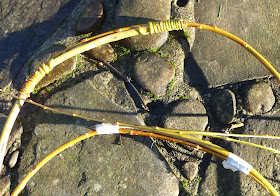 Willow grows fast. In 2002, I planted different coloured rods to grow a living willow dome for the kids to play in the back garden. Despite weaving ends in and pruning, by 2010, it had put half the garden in deep shade. Chopping the top off left this wildly intertwined enclosure. Each spring, the new growth is so vigorous that egg chair is quite private by summer.
Willow grows fast. In 2002, I planted different coloured rods to grow a living willow dome for the kids to play in the back garden. Despite weaving ends in and pruning, by 2010, it had put half the garden in deep shade. Chopping the top off left this wildly intertwined enclosure. Each spring, the new growth is so vigorous that egg chair is quite private by summer.The object turned out to be a willow basket for raw sheep fleece, possibly for warming the lanolin by the fireside before carding, possibly for gathering bits of loose fleece. Variously known as a crealagh, muirlag or ciarachan, discussions on Ravelry gave links to Woven Communities website, where there is a phototutorial called How to make a Mudag. Some years ago, I tried willow weaving, following instructions in a book called Handmade Baskets by Susie Vaughan. I've never made a frame basket, but with all this willow, what did I have to lose? I managed to tape four lengths into hoops and put them in a round trug to dry. Last Saturday, when I took them out, they stayed reasonably circular. All the other lengths had been rolled in a towel and were sodden with rain. This had made them much more flexible than when I cut them.
Even so, I had to split one of the thinnest twigs down the middle to make it bendy enough to wrap the cut ends of the hoop together when I took off the tape. Not possible to tie a knot, so I put the thin end between the layers of the hoop and bound back over it, then pulled the thick end between the layers to wedge it tight. .
There is a diagram for the God's Eye on Woven Communities. To get a long enough, supple enough length for this, I peeled a thick layer of bark off one of the biggest sticks. To finish, the loose end was pulled through the last turn and woven against the adjacent rib as I made the body. The God's Eye was a godsend when it came to fitting all the ribs. In the picture of the real thing, a single in and out weave is used, which needs an odd number of uprights. Three ribs per quarter sat safely and looked good, adding or removing one just didn't work.
 The God's Eyes were wide and firm enough to support the ribs under their own tension, when bent into place.
The God's Eyes were wide and firm enough to support the ribs under their own tension, when bent into place. Having sixteen ribs, I decided to weave with a pair of willow lengths twisting round each other in between each stake. I don't know what this is called, but it is the basic technique shown in 'Handmade Baskets' and it does work for any number of ribs. Once I had made a start on both ends, I took the tape off and it held perfectly solid.
By this point it was getting dark, my hands were aching and my feet freezing from sitting still, but I was most encouraged. Completing the body, it was touch and go whether there would be enough lengths of willow. To fill in the middle, I had to resort to using up weedy bits which were too short, really, or the thickest ones which didn't want to bend neatly.
By Sunday teatime, I had a finished object. It is strong and can withstand maltreatment by those who have noticed its likeness to a rugby ball and think it funny to toss it round the kitchen while I squeak with alarmed outrage. The golden willow is bound to fade to brown and shrink a bit. The whole thing already has an amateur wonkiness, but I am chuffed.
My own muirlag. Time to find out whether carding warm wool is easier. I might try it out collecting bits off fleece off the moor next May.
It certainly makes a better fireside ornament than wet boots.









What a lovely thing you have created; feeling inspired to make one of my own now, thanks for sharing :)
ReplyDeletex
That looks great - I love willow for baskets.
ReplyDeleteexcellent :)
ReplyDeleteThanks very much for the nice remarks.
DeleteThat is lovely - wonder what else I could use something like that for?
ReplyDeleteI've had a few suggestions from the ever-loving family ...
DeleteWant one! My willow isn't big enough yet :(
ReplyDeleteThat is amazing!! I LOVE it! you are both a clever and inventive lady.
ReplyDeleteThanks for this, a lovely basket, I'm so inspired
ReplyDeleteBeautiful and a true Original Well Done you
ReplyDeleteThis looks great! It is going to keep you very busy as it grows so fast supplying you with plenty of material. I remember weaving willow at school years ago but hope to have another shot at it again soon
ReplyDeleteKeep it up love the blog
Susan x
Among the female alpacas for sale at Island Alpacas are Annie, Kolette, and Lunette. Each female has an exceptional pedigree, including a dam with a history of success in the alpaca show ring. Find more interesting information about Inca Grand Design - Hensting Alpacas - Home of the Alpaca here.
ReplyDelete